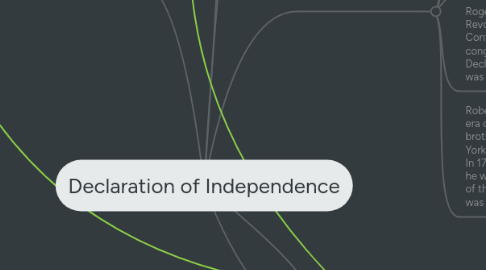Declaration of Independence
저자: Nicholas Jozsa


1. 5 parts of the Declaration
1.1. Will "declare" the "causes" that have made it necessary for the American colonies to leave the British Empire.
1.2. Declaration gives evidence of the "long train of abuses and usurpations" heaped upon the colonists by King George III.
1.3. That the colonists had appealed in vain to their "British brethren" for a redress of their grievances.
1.4. The preamble sets out principles that were already recognized to be "self-evident" by most 18th- century Englishmen, closing with the statement that "a long train of abuses and usurpations . . . evinces a design to reduce [a people] under absolute Despotism, it is their right, it is their duty, to throw off such Government, and to provide new Guards for their future security.
1.5. the Declaration concludes that "these United Colonies are, and of Right ought to be Free and Independent States; that they are Absolved from all Allegiance to the British Crown, and that all political connection between them and the State of Great Britain, is and ought to be totally dissolved."
2. http://www.history.com/topics/american-revolution/declaration-of-independence
3. Image of the Committee of Five: http://upload.wikimedia.org/wikipedia/commons/4/44/Committee_of_Five.jpg
4. Significance
4.1. Jefferson retained his prominent role in writing the defining document of the American Revolution and, indeed, of the United States. Jefferson was critical of changes to the document, particularly the removal of a long paragraph that attributed responsibility of the slave trade to British King George III. Jefferson was justly proud of his role in writing the Declaration of Independence and skillfully defended his authorship of this hallowed document.
4.2. John Adams: https://www.youtube.com/watch?v=nrvpZxMfKaU
4.3. Benjamin Franklin: Benjamin Franklin, then a member of the Secret Committee of Correspondence, hinted to French agents and other European sympathizers that the colonies were increasingly leaning towards seeking independence. While perhaps true, Franklin also hoped to convince the French to supply the colonists with aid. Independence would be necessary, however, before French officials would consider the possibility of an alliance.
4.4. Roger Sherman: He was appointed commissary to the Connecticut Troops at the start of the Revolutionary war; this was experience that he put to great use when he was elected to the Continental Congress in 1774. Sherman was a very active and much respected Delegate to the congress. He served and numerous committees, including the committee to draft the Declaration of Independence. He served all through the war for Independence. As active as he was in Congress, he simultaneously fulfilled his other offices.
4.5. Robert R. Livingston: Livingston became politically active in the era of the Stamp Act Revolt, and was probably (along with his brother, William), involved with the Sons of Liberty in New York. In 1776, as a member of the Provincial congress of New York, he was selected to attend the Continental Congress. He was one of the committee to draft the Declaration of Independence but was recalled by his state before he could sign it.
5. Participants
5.1. Thomas Jefferson
5.1.1. Roger Sherman
5.2. John Adams
5.3. Benjamin Franklin
5.3.1. Robert R. Livingston
